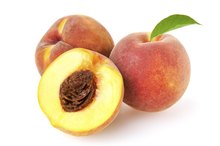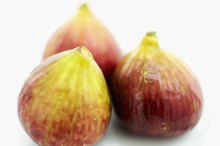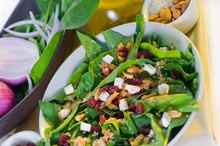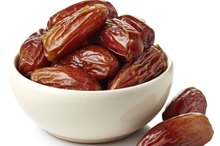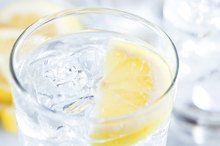Can You Eat Too Many Cranberries?
No food is safe from the dangers of overeating, but fiber-rich fruits and vegetables are less likely to have a negative effect if they are over-consumed. Cranberries are fiber-rich and full of antioxidants, which earns them a reputation as a "superfood." However, eating the proper serving size will assure that you gain the benefits without unwanted weight gain or other complications.
Nutrition and Health Benefits
A 1/2 cup serving of fresh cranberries contains only 30 calories, 6 g carbs and 2 g fiber. Cranberries can be eaten dried, fresh, frozen or canned. You should always check labels for added ingredients in canned and dried fruits, as they may contain syrups, sugars and other extra hidden carbs.
Amy Howell, a Rutgers University researcher, reports to MSNBC the many health benefits of cranberries. Research has found the drinking cranberry juice can actually help prevent urinary tract infections. Howell's research found a compound in cranberries, known as "proanthocyanidine," that prevents plaque from forming on the teeth. Finally, cranberries and cranberry juice can kill some bacterias that cause ulcers and even stomach cancer.
- A 1/2 cup serving of fresh cranberries contains only 30 calories, 6 g carbs and 2 g fiber.
- Howell's research found a compound in cranberries, known as "proanthocyanidine," that prevents plaque from forming on the teeth.
Adding Up the Calories
Cherries and Weight Loss
Learn More
At 30 calories per cup for fresh cranberries, overeating is not as dangerous as it can be with other higher-calorie foods like peanuts, almonds or other fattening snacks like potato chips. If you were to eat 4 cups of cranberries, a very large, you would still only consume 120 calories. However, consuming large amounts of cranberry sauce or cranberry juice can easily pack on more calories, because these foods are much higher in calories than raw cranberries.
Issues with Fiber
A half-cup serving of cranberries contains only a moderate amount of fiber, but if you eat too many, you might end up consuming several grams of fiber in one sitting. While fiber offers health benefits, too much at one time can negatively affect your digestive tract, causing diarrhea, constipation, bloating, gas and abdominal pain, especially if you're not used to a high fiber intake. Keep your cranberry portions moderate -- between one-half and one cup -- to prevent these problems.
Tips for Success
Are Mangoes Good for Dieting?
Learn More
Focus on satiety to prevent over-eating cranberries. Choose whole cranberries over juices helps fill the stomach and produce satiety. Combine cranberries with other filling foods and ingredients so you won't be tempted to eat large amounts of berries. For example, try baking fresh cranberries into whole-grain bran muffins, or top your oatmeal with fresh cranberries and toasted chopped pecans. The whole grains in both foods help fill your stomach, and provide fiber to help you feel satisfied.
- Focus on satiety to prevent over-eating cranberries.
- Combine cranberries with other filling foods and ingredients so you won't be tempted to eat large amounts of berries.
Related Articles
References
- MSNBC: Research Shows Benefits of Cranberries
- LIVESTRONG; MyPlate: Cranberries
- Linus Pauling Institute: Fiber
- Cranberries, raw. FoodData Central. U.S. Department of Agriculture. Published April 1, 2019.
- Cranberry sauce, canned, sweetened. FoodData Central. U.S. Department of Agriculture. Published April 1, 2019.
- Cranberries, dried, sweetened. FoodData Central. U.S. Department of Agriculture. Published April 1, 2019.
- Mukherjee M, Bandyopadhyay P, Kundu D. Exploring the role of cranberry polyphenols in periodontits: A brief review. J Indian Soc Periodontol. 2014;18(2):136‐139. doi:10.4103/0972-124X.131301
- Nicolosi D, Tempera G, Genovese C, Furneri PM. Anti-adhesion activity of A2-type proanthocyanidins (a cranberry major component) on uropathogenic E. coli and P. mirabilis strains. Antibiotics (Basel). 2014;3(2):143-54. doi:10.3390/antibiotics3020143
- Seyyedmajidi M, Ahmadi A, Hajiebrahimi S, et al. Addition of cranberry to proton pump inhibitor-based triple therapy for eradication. J Res Pharm Pract. 2016;5(4):248-251. doi:10.4103/2279-042X.192462
- Novotny JA, Baer DJ, Khoo C, Gebauer SK, Charron CS. Cranberry juice consumption lowers markers of cardiometabolic risk, including blood pressure and circulating C-reactive protein, triglyceride, and glucose concentrations in adults. J Nutr. 2015;145(6):1185-93. doi:10.3945/jn.114.203190
- Wilson T, Luebke JL, Morcomb EF, et al. Glycemic responses to sweetened dried and raw cranberries in humans with type 2 diabetes. J Food Sci. 2010;75(8):H218-23. doi:10.1111/j.1750-3841.2010.01800.x
- Blumberg JB, Camesano TA, Cassidy A, et al. Cranberries and their bioactive constituents in human health. Adv Nutr. 2013;4(6):618‐632. Published 2013 Nov 6. doi:10.3945/an.113.004473
- Drugs and Lactation Database. National Library of Medicine Updated December 3, 2018.
- Cranberry. National Center for Complementary and Integrative Health (NCCIH).Updated November 2016.
- Gul Z, Monga M. Medical and dietary therapy for kidney stone prevention. Korean J Urol. 2014;55(12):775-9. doi:10.4111/kju.2014.55.12.775
Writer Bio
Jan Archer holds a Bachelor of Arts in political science and a master's degree in creative writing. Roth has written trade books for Books-a-Million and has published articles on green living, wellness and education topics. She taught business writing, literature, creative writing and English composition at the college level for five years.


